Green-haired turtle that breathes through its genitals added to endangered list
Patrick Barkham and agencies
With its punky green mohican the striking Mary river turtle joins a new ZSL list of the world’s most vulnerable reptiles.

The Mary River turtle, found in Queensland, Australia, features on a new list of the most vulnerable reptile species on the planet. Photograph: Chris Van Wyk/ZSL/PA










